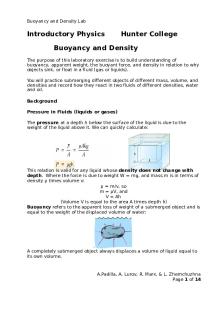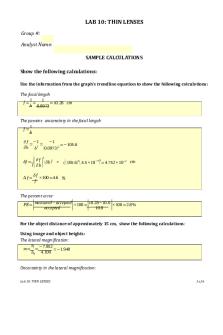Lab 10 PDF

| Title | Lab 10 |
|---|---|
| Author | Heather Holtrop |
| Course | Expt Organic Chemistry I |
| Institution | Texas Tech University |
| Pages | 5 |
| File Size | 156.9 KB |
| File Type | |
| Total Downloads | 66 |
| Total Views | 178 |
Summary
Lab Report...
Description
Jason Chau 11/7/14, CHEM 3105-390 TA – Yunxiang Li Lab #10: The E2 Elimination Reaction
Purpose: This reaction illustrates the base-induced dehydrohalogention of alkyl halides with strong base and is used extensively for the preparation of alkenes. The stereo- and regiochemical effects of the size of the base are investigated, and the product mixture can be analyzed by the use of gas chromatography. Reaction and Physical Properties Table: H
H
C=C H
CH2(CH2)3CH3 1-heptene
M+ OR-
H3C
CH2(CH2)2CH3
CH3CH(CH2)4cCH3 Br
+
C=C
ROH H
H
H3C
ROH
Cis-2-heptene H
C=C H CH2(CH2)2CH3 Trans-2-heptene
Compound
MW
Amount
mmol
2Bromoheptane
179.10
0.15ml
0.92
25% (w) soln sodium methoxide Methanol 2- Methyl2-propanol (tertbutano) Potassium tertbutoxide
53.98
1.10ml
5.09
32.04 74.12
1.90ml 3.0ml
112.21
0.56g
5.00
bp( °C ¿ 165-167
1.128
64.9 82-830
0.791 .786
256-258
d
nD
1.3288 1.3838
+
BR-
Safety: There are periods of waiting in this lab, but do not take off your goggles in the laboratory Organic compounds are highly flammable handle every chemical with ease Avoid coming in direct contact with chemicals wear gloves when handling chemicals. 2-Bromoheptane Ingestion: If swallowed, wash out mouth with water provided person is conscious. Call a physician. Inhalation: If inhaled, remove to fresh air. If not breathing, give artificial respiration. If breathing is difficult, give oxygen. Skin: In case of contact, immediately wash skin with soap and copious amounts of water.
Methanol Ingestion: Toxic if swallowed. May be fatal or cause blindness if swallowed. Ingestion of this product may result in central nervous system effects including headache, sleepiness, dizziness, slurred speech and blurred vision. Inhalation: Toxic by inhalation. May cause blindness if inhaled. Skin: Toxic in contact with skin. Skin absorption may cause toxic effects similar those described for inhalation.
Procedure 1. Begin heating a hot plate to a 100-110C. 2. Add a spin vane to a 5 mL conical vial. 3. Add 1.1 mL of sodium methoxide, in methanol. 4. Add 1.9 mL of dry methanol and .15 mL of 2-bromo and then attach the vial to a reflux condenser. a. Make sure to add a calcium chloride drying tube. 5. Start stirring and let the reaction heat for 30 minutes. 6. Begin heating a hot plate to 140-150C. 7. Add a spin vane to a 5 mL conical vial. 8. Add .56 grams of potassium tert-butoxide and .15 mL of 2-bromo. 9. Attach to a reflux condenser. a. Make sure to add a calcium chloride drying tube. 10. Start stirring and let the reaction heat for 30 minutes. 11. Cool the vial, and let the vial get to room temperature. 12. Remove the spin vane. a. Add 1 mL of pentane, and .5 mL water to the reaction vial.
13. Transfer the mixture to a centrifuge tube. 14. Rinse the conical vial with a solution of pentane and then water. a. Make sure to transfer each rinse to the centrifuge tube. 15. Cap the tube, then shake until the white solid dissolves. a. If needed, add more drops of water to dissolve completely. 16. Separate the lower aqueous layer. a. For potassium reactions, separate the organic layer with 2x1mL KOH and then two more 1 mL portions of water. b. For the sodium meth. reactions, extract the organic layer with two 1 mL portions of water. 17. Each extraction is transferred to the same flask. 18. Dry the organic layer with magnesium sulfate. 19. Transfer the final product to a shell vial. Data/Observations The solid tert-butanol was added and the spinning vain slowed. It took awhile for the vain to displace the solution. After 30 minutes of heating and stirring the solution appeared to be yellow. After transferring to the centrifuge tube and extracting the aqueous layer the solution was washed with potassium chloride. The smell of the sample was of a citrus smell The Graph Our graph did not show an expected yield Sample 2 showed peaks of all the compounds, 1-Heptane at 2.98, trans 2-Heptane at 3.38, and cis 2-Heptane at 3.2 The other base that was used showed impurities (water) at peaks at different times than the samples with methanol used as the base. Conclusions/Discussion We did one part of the whole experiment. We formed a solution in a conical vial and heated it for thirty minutes. After cooling the vial, the mixture was transferred to a centrifuge tube. We then cleaned out the conical vial with a KOH and water solution, and added each wash to the centrifuge tube. Extractions were made, and the final organic layer was dried with magnesium sulfate. The final, clear product was transferred to a small shell vial. The lab was successful, and we had much of the final product to store.
Post Lab Questions 6-30. Outline a complete mechanism sequence for the reaction of 2-bromoheptane with potassium 2-methyl-2-propoxide in 2-methyl-2-propanol solvent to form the three
alkanes generated in the reaction. Include a clear drawing of the anti-periplanar transition state for the formation of each alkene. Formation of 1-heptene Potassium 2-methyl-2-propoxide acts as a base. This reacted with 2-bromoheptane to form 1-heptene. The terminal beta hydrogen in 2-bromoheptane is anti-periplaner with the Br group.
Formation of trans 2-heptene Same base reacts with 2-bromoheptane to form 2-heptene. Substrate undergoes E2 mechanism
Formation of cis 2-heptene Same base reacts with 2-bromoheptane to form cis 2-heptene. In Newman projection the H and Br are anti-periplanar. Bulky groups are on the same side of the plane. This will go E2 mechanism
6-31. Predict the predominant alkene product that would form when 2-bromomethylpentane is treated with sodium methoxide in methanol. If the base were changed to
KOC(CH2CH3)3 would the same alkene predominant? If not, why? What would be the structure of this alternate product, if it formed? The more occurring product resulting form the use of sodium methoxide is the more highly substituted alkene, 2-methyl-2-pentene. The more occurring product resulting form the use of –OC(CH2CH3)3 as the base would be 2-methyl-1-pentene. –OC(CH2CH3)3 is bulky, formation of its product would require removal of a proton off the less hindered methyl groups.
6.32. Predict the more stable alkene of each of the following pairs. A) Trans 3-hexene is the more stable B) Trans 3-hexene is the more stable C) 2,3-dimethyl 2-pentene is the more stable...
Similar Free PDFs

Lab 10 - Lab 10
- 17 Pages

Lab 10 - Lab 10 Report
- 7 Pages

GEOG Lab 10 - lab 10
- 4 Pages

Lab 10 - PH111 LAB
- 2 Pages

Lab 10
- 14 Pages

Lab # 10
- 4 Pages

Lab 10
- 4 Pages

Lab 10
- 5 Pages

Orgo 2 Lab 10 - Lab Report 10
- 4 Pages

Post lab 10 - Post lab 10
- 3 Pages

Lab 10 - Lecture notes 10
- 3 Pages

Chem lab 10 - lab report
- 9 Pages

Phys lab 10 - Lab report
- 14 Pages

Practica lab 10
- 15 Pages

Lab 10 thin lenses
- 6 Pages

eScience Lab 10: Cells
- 6 Pages
Popular Institutions
- Tinajero National High School - Annex
- Politeknik Caltex Riau
- Yokohama City University
- SGT University
- University of Al-Qadisiyah
- Divine Word College of Vigan
- Techniek College Rotterdam
- Universidade de Santiago
- Universiti Teknologi MARA Cawangan Johor Kampus Pasir Gudang
- Poltekkes Kemenkes Yogyakarta
- Baguio City National High School
- Colegio san marcos
- preparatoria uno
- Centro de Bachillerato Tecnológico Industrial y de Servicios No. 107
- Dalian Maritime University
- Quang Trung Secondary School
- Colegio Tecnológico en Informática
- Corporación Regional de Educación Superior
- Grupo CEDVA
- Dar Al Uloom University
- Centro de Estudios Preuniversitarios de la Universidad Nacional de Ingeniería
- 上智大学
- Aakash International School, Nuna Majara
- San Felipe Neri Catholic School
- Kang Chiao International School - New Taipei City
- Misamis Occidental National High School
- Institución Educativa Escuela Normal Juan Ladrilleros
- Kolehiyo ng Pantukan
- Batanes State College
- Instituto Continental
- Sekolah Menengah Kejuruan Kesehatan Kaltara (Tarakan)
- Colegio de La Inmaculada Concepcion - Cebu